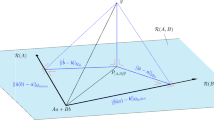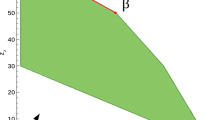Abstract
Submodular optimization is widely used in large datasets. In order to speed up the problems solving, it is essential to design low-adaptive algorithms to achieve acceleration in parallel. In general, the function values are given by a value oracle, but in practice, the oracle queries may consume a lot of time. Hence, how to strike a balance between optimizing them is important. In this paper, we focus on maximizing a normalized and strictly monotone set function with the diminishing-return ratio \(\gamma \) under a cardinality constraint, and propose two algorithms to deal with it. We apply the adaptive sequencing technique to devise the first algorithm, whose approximation ratio is arbitrarily close to \(1-\mathrm{e}^{-\gamma }\) in \(O(\log n \cdot \log (\log \frac{k}{\gamma }))\) adaptive rounds, and requires \(O(n^2\cdot \log (\log \frac{k}{\gamma }))\) queries. Then by adding preprocessing and parameter estimation steps to the first algorithm, we get the second one. The second algorithm trades a small sacrifice in adaptive complexity for a significant improvement in query complexity. With the same approximation and adaptive complexity, the query complexity is improved to \(O(n\cdot \log (\log \frac{k}{\gamma }))\). To the best of our knowledge, this is the first paper of designing adaptive algorithms for maximizing a monotone function using the diminishing-return ratio.
Similar content being viewed by others
References
Goemans, M.X., Williamson, D.P.: Improved approximation algorithms for maximum cut and satisfiability problems using semidefinite programming. J. ACM 42(6), 1115–1145 (1995)
Feige, U.: A threshold of \(\ln n\) for approximating set cover. J. ACM 45(4), 634–652 (1998)
Ageev, A.A., Sviridenko, M.I.: An 0.828-approximation algorithm for the uncapacitated facility location problem. Discrete Appl. Math. 3, 149–156 (1999)
Cornnejols, G., Fisher, M., Nemhauser, G.: Location of bank accounts of optimize float: an analytic study of exact and approximate algorithm. Manag. Sci. 23, 789–810 (1977)
Nemhauser, G.L., Wolsey, L.A., Fisher, M.L.: An analysis of approximations for maximizing submodular set functions. Math. Program. 14(1), 265–294 (1978)
Balkanski, E., Singer, Y.: The adaptive complexity of maximizing a submodular function. In: STOC, pp. 1138–1151 (2018)
Balkanski, E., Rubinstein, A., Singer, Y.: An exponential speedup in parallel running time for submodular maximization without loss in approximation. In: SODA, pp. 283–302 (2019)
Fahrbach, M., Mirrokni, V., Zadimoghaddam, M.: Submodular maximization with nearly optimal approximation, adaptivity and query complexity. In: SODA, pp. 255–273 (2019)
Ene, A., Nguyen, H.L.: Submodular maximization with nearly-optimal approximation and adaptivity in nearly-linear time. In: SODA, pp. 274–282 (2019)
Breuer, A., Balkanski, E., Singer, Y.: The FAST algorithm for submodular maximization. In: ICML, pp. 1134–1143 (2020)
Balkanski, E., Rubinstein, A., Singer, Y.: An optimal approximation for submodular maximization under a matroid constraint in the adaptive complexity model. In: STOC, pp. 66–77 (2019)
Fahrbach, M., Mirrokni, V., Zadimoghaddam, M.: Non-monotone submodular maximization with nearly optimal adaptivity and query complexity. In: ICML, pp. 1833–1842 (2019)
Kuhnle, A.: Nearly linear-time, parallelizable algorithms for non-monotone submodular maximization. In: AAAI, pp. 8200–8208 (2021)
Krause, A., Singh, A., Guestrin, C.: Near-optimal sensor placements in Gaussian processes: theory, efficient algorithms and empirical studies. J. Mach. Learn. Res. 9, 235–284 (2008)
Lin, Y., Chen, W., Lui, J.C.S.: Boosting information spread: an algorithmic approach. In: ICDE, pp. 883–894 (2017)
Das, A., Kempe, D.: Submodular meets spectral: Greedy algorithms for subset selection, sparse approximation and dictionary selection. In: ICML, pp. 1057–1064 (2011)
Kuhnle, A., Smith, J.D., Crawford, V.G., Thai, M.T.: Fast maximization of nonsubmodular, monotonic functions on the integer lattice. In: ICML, pp. 2791–2800 (2018)
Nong, Q., Sun, T., Gong, S., Fang, Q., Du D., Shao X.: Maximize a monotone function with a generic submodularity ratio. In: AAIM, pp. 249–260 (2019)
Badanidiyuru, A., Vondrák, J.: Fast algorithm for maximization submodular functions. In: SODA, pp. 1497–1514 (2014)
Hassidim, A., Singer, Y.: Robust guarantees of stochastic greedy algorithms. In: ICML, pp. 1424–1432 (2017)
Author information
Authors and Affiliations
Corresponding author
Ethics declarations
Author Contributions
All authors contributed to the study conception and design of this paper.
Conflicts of interest
The authors declare that there is no conflict of interests regarding the publication of this paper.
Additional information
This research was supported by the National Natural Science Foundation of China (Nos. 11971447 and 11871442), and the Fundamental Research Funds for the Central Universities.
Rights and permissions
About this article
Cite this article
Liu, B., Su, H., Gong, SF. et al. Adaptive Algorithms on Maximizing Monotone Nonsubmodular Functions. J. Oper. Res. Soc. China 12, 428–445 (2024). https://doi.org/10.1007/s40305-022-00407-7
Received:
Revised:
Accepted:
Published:
Issue Date:
DOI: https://doi.org/10.1007/s40305-022-00407-7




